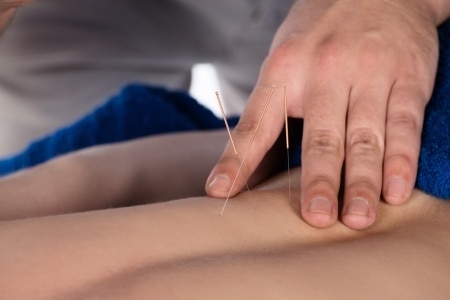It should come as no surprise that pain is a natural part of the human experience. If it weren’t for pain, we wouldn’t know that we were burning our hand in a fire or stepping on a sharp nail with our foot. Pain is an incredibly valuable tool nature has equipped us with to keep us safe from harm.
But what about those times when we experience pain without an obvious cause of danger? Sometimes those symptoms can be caused by myofascial dysfunction commonly known as “knots” or “trigger points.” Myofascial dysfunction can present itself in many different forms such as: low back pain, neck pain, IT Band Syndrome, Plantar Fasciitis or Tennis Elbow to name just a few.
The good news is that for many of us, time will alleviate our painful backs and necks within a few weeks. However, there are those who can’t seem to get rid of their pain regardless of what they do. These people may benefit from seeing a physical therapist to discuss a treatment called, Trigger Point Dry Needling.
Trigger Point Dry Needling is a comfortable and safe procedure that uses thin, filiform needles to deactivate painful knots in our muscles based on the physical therapist’s examination findings. This treatment is a great way to get muscles to relax quickly. Once those muscles have relaxed, people usually see an improvement in mobility and a decrease in pain which allows them to resume their normal, active lives sooner.
A typical session of Trigger Point Dry Needling can vary from practitioner to practitioner based on their training. However, generally speaking, the physical therapist will identify the tissue he or she believes is tight and stick one or more needles into that tissue. The therapist may “piston” the needle which is a technique of rapidly moving the needle in and out of the trigger point. This may cause some mild muscle cramping and leave one feeling sore for a few hours like after a hard workout. Usually, the soreness associated with pistoning is far less than the pain associated with the actual trigger point itself and many times, the patient will feel little to no discomfort at all.
How does Trigger Point Dry Needling work? While the exact mechanism is not fully understood, there are several competing hypotheses surrounding this topic. One thought is that the microtrauma from the needle allows fresh blood into the sick tissue to jump start the healing process. Another is that the metal needle disrupts the bioelectrical field within the muscles, returning the muscle back to homeostasis. Perhaps the most profound hypothesis is that the needle “taps into the nervous system” and causes the brain to block the pain signals it would normally receive from that dysfunctional tissue. Although it is unclear which of these mechanisms is at play at any given time, we do know that people do experience some form of relief from their pain when a needle is placed in the appropriate tissue.
While Trigger Point Dry Needling does, in fact, use a needle to treat myofascial pain, it is important to distinguish the difference between Acupuncture. Acupuncture is based on Traditional Chinese Medicine which relies not only on needles but other means of treatment as well such as tongue and pulse diagnosis, herbs, nutrition, psychology, etc. When an Acupuncturist does treat you with needles, he or she looks to correct imbalances in “qi” through channels known as meridians. Conversely, a physical therapist will perform a neuromuscular assessment that looks at muscle strength and length, joint mobility and pain patterns. Based on those findings, the therapist will treat the tissue he or she thinks is most likely contributing to your pain. While this can sound confusing, it is easiest to think of it in these terms: both types of practitioners are using the same tool but have completely different skill sets and therefore, use the tool differently.
The bottom line is this: myofascial dysfunction can be debilitating at times but it doesn’t have to become a permanent part of your life or identity. If you believe you are suffering from severely tight, painful muscles, ask your physical therapist if he or she can help you with Trigger Point Dry Needling. If you have any questions about what dry needling looks like, check out the link below. And if you have any questions about this article or anything else please feel free to contact us at 479-402-9400.




